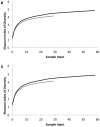Molecular diet analysis of two african free-tailed bats (molossidae) using high throughput sequencing
- PMID: 21731749
- PMCID: PMC3120876
- DOI: 10.1371/journal.pone.0021441
Molecular diet analysis of two african free-tailed bats (molossidae) using high throughput sequencing
Abstract
Given the diversity of prey consumed by insectivorous bats, it is difficult to discern the composition of their diet using morphological or conventional PCR-based analyses of their faeces. We demonstrate the use of a powerful alternate tool, the use of the Roche FLX sequencing platform to deep-sequence uniquely 5' tagged insect-generic barcode cytochrome c oxidase I (COI) fragments, that were PCR amplified from faecal pellets of two free-tailed bat species Chaerephon pumilus and Mops condylurus (family: Molossidae). Although the analyses were challenged by the paucity of southern African insect COI sequences in the GenBank and BOLD databases, similarity to existing collections allowed the preliminary identification of 25 prey families from six orders of insects within the diet of C. pumilus, and 24 families from seven orders within the diet of M. condylurus. Insects identified to families within the orders Lepidoptera and Diptera were widely present among the faecal samples analysed. The two families that were observed most frequently were Noctuidae and Nymphalidae (Lepidoptera). Species-level analysis of the data was accomplished using novel bioinformatics techniques for the identification of molecular operational taxonomic units (MOTU). Based on these analyses, our data provide little evidence of resource partitioning between sympatric M. condylurus and C. pumilus in the Simunye region of Swaziland at the time of year when the samples were collected, although as more complete databases against which to compare the sequences are generated this may have to be re-evaluated.
Conflict of interest statement
Figures





References
-
- Kohn MH, Wayne RK. Facts from faeces revisited. Trend Evol Ecol. 1997;12:223–227. - PubMed
-
- Symondson WOC. Molecular identification of prey in predator diets. Mol Ecol. 2002;11:627–641. - PubMed
-
- Clare EL, Fraser EE, Braid HE, Fenton BM, Hebert PDN. Species on the menu of a generalist predator, the eastern red bat (Lasiurus borealis): using a molecular approach to detect arthropod prey. Mol Ecol. 2009;18:2532–2542. - PubMed
-
- Clare EL, Barber BR, Sweeney BW, Hebert PDN, Fenton MB. Eating local: Influences of habitat on the diet of little brown bats (Myotis lucifugus). Mol Ecol. (in press) - PubMed
-
- Goerlitz HR, Hofstede HM, Zeale MRK, Jones G, Holderied MW. An aerial-hawking bat uses stealth echolocation to counter moth hearing. Curr Biol. 2010;20:1568–1572. - PubMed
MeSH terms
LinkOut - more resources
Full Text Sources

